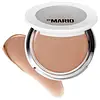Makeup by Mario Soft Pop Plumping Blush Veil Versus Makeup by Mario Softsculpt Transforming Skin Enhancer
What's inside
What's inside
 Key Ingredients
Key Ingredients

 Benefits
Benefits

No benefits
 Concerns
Concerns

 Ingredients Side-by-side
Ingredients Side-by-side

C15-19 Alkane
SolventOctyldodecanol
EmollientTridecyl Trimellitate
EmollientPentaerythrityl Tetraisostearate
EmollientSynthetic Wax
AbrasiveRaphanus Sativus Seed Extract
Skin ConditioningMicrocrystalline Wax
Emulsion StabilisingSynthetic Fluorphlogopite
Silica Silylate
EmollientMica
Cosmetic ColorantHydrogenated Rice Bran Wax
Skin ConditioningDicalcium Phosphate
AbrasiveDisteardimonium Hectorite
StabilisingHelianthus Annuus Seed Oil
EmollientOryza Sativa Bran Wax
Skin ConditioningPentaerythrityl Tetra-Di-T-Butyl Hydroxyhydrocinnamate
AntioxidantRosmarinus Officinalis Leaf Extract
AntimicrobialTocopheryl Acetate
AntioxidantRicinus Communis Seed Oil
MaskingHydrolyzed Sodium Hyaluronate
Skin ConditioningSodium Hyaluronate
HumectantHydrogenated Castor Oil
EmollientTin Oxide
AbrasiveCI 77891
Cosmetic ColorantCI 77491
Cosmetic ColorantCI 42090
Cosmetic ColorantCI 15850
Cosmetic ColorantCI 45410
Cosmetic ColorantC15-19 Alkane, Octyldodecanol, Tridecyl Trimellitate, Pentaerythrityl Tetraisostearate, Synthetic Wax, Raphanus Sativus Seed Extract, Microcrystalline Wax, Synthetic Fluorphlogopite, Silica Silylate, Mica, Hydrogenated Rice Bran Wax, Dicalcium Phosphate, Disteardimonium Hectorite, Helianthus Annuus Seed Oil, Oryza Sativa Bran Wax, Pentaerythrityl Tetra-Di-T-Butyl Hydroxyhydrocinnamate, Rosmarinus Officinalis Leaf Extract, Tocopheryl Acetate, Ricinus Communis Seed Oil, Hydrolyzed Sodium Hyaluronate, Sodium Hyaluronate, Hydrogenated Castor Oil, Tin Oxide, CI 77891, CI 77491, CI 42090, CI 15850, CI 45410
C15-19 Alkane
SolventOctyldodecanol
EmollientPentaerythrityl Tetraisostearate
EmollientTridecyl Trimellitate
EmollientSynthetic Wax
AbrasiveRaphanus Sativus Seed Extract
Skin ConditioningCera Microcristallina
Emulsion StabilisingSynthetic Fluorphlogopite
Silica Silylate
EmollientMica
Cosmetic ColorantCalcium Dihydrogen Phosphate
BufferingDisteardimonium Hectorite
StabilisingTocopheryl Acetate
AntioxidantMethyl Di-T-Butyl Hydroxyhydrocinnamate
AntioxidantHelianthus Annuus Flower
Skin ConditioningRosmarinus Officinalis Leaf Extract
AntimicrobialSilicon/Titanium/Cerium/Iron Oxides
C15-19 Alkane, Octyldodecanol, Pentaerythrityl Tetraisostearate, Tridecyl Trimellitate, Synthetic Wax, Raphanus Sativus Seed Extract, Cera Microcristallina, Synthetic Fluorphlogopite, Silica Silylate, Mica, Calcium Dihydrogen Phosphate, Disteardimonium Hectorite, Tocopheryl Acetate, Methyl Di-T-Butyl Hydroxyhydrocinnamate, Helianthus Annuus Flower, Rosmarinus Officinalis Leaf Extract, Silicon/Titanium/Cerium/Iron Oxides
Ingredients Explained
These ingredients are found in both products.
Ingredients higher up in an ingredient list are typically present in a larger amount.
C15-19 alkane is a mixture of alkanes. Alkanes are hydrocarbons with carbon atoms held together by single bonds.
It is a synthetically created solvent and emollient often used to replace silicones or mineral oil. As an emollient, C15-19 Alkane helps soften and soothe the skin. Emollients create a barrier to trap moisture inside.
C15-19 Alkane is often used with mineral UV filters such as titanium dioxidide and zinc oxide. It helps these UV filter ingredients be more spreadable.
C15-19 Alkane is biodegradable.
Learn more about C15-19 AlkaneDisteardimonium Hectorite comes from the clay mineral named hectorite. It is used to add thickness to a product.
It can also help stabilize a product by helping to disperse other ingredients.
Hectorite is a rare, white clay mineral.
Learn more about Disteardimonium HectoriteMica is a naturally occurring mineral used to add shimmer and color in cosmetics. It can also help improve the texture of a product or give it an opaque, white/silver color.
Serecite is the name for very fine but ragged grains of mica.
This ingredient is often coated with metal oxides like titanium dioxide. Trace amounts of heavy metals may be found in mica, but these metals are not harmful in our personal products.
Mica has been used since prehistoric times throughout the world. Ancient Egyptian, Indian, Greek, Roman, Aztec, and Chinese civilizations have used mica.
Learn more about MicaOctyldodecanol is a fatty alcohol. It is primarily used to enhance the texture of products.
As an emulsifier, Octyldodecanol helps prevent the oils and waters from separating. It also prevents ingredients from creating foam when shaken.
Octyldodecanol is created by reducing fatty acid to an alcohol.
Due to its high molecular weight, it does not get absorbed into the skin.
Learn more about OctyldodecanolPentaerythrityl Tetraisostearate is derived from isostearic acid. It is an emollient and emulsifier.
The highest concentration of this ingredient is found in lipsticks.
This ingredient is minimally water soluble and may not be Malassezia folliculitis, or fungal-acne safe.
Learn more about Pentaerythrityl TetraisostearateWe don't have a description for Raphanus Sativus Seed Extract yet.
Rosmarinus Officinalis Leaf Extract comes from rosemary. Rosemary is native to the Mediterranean.
While Rosmarinus Officinalis Leaf Oil can be volatile due to its fragrant properties, the fragrance components are usually removed in the leaf extract.
Rosemary Leaf Extract contains many antioxidants such as rosmarinic acid and caffeic acid. Rosemarinic acid, a compound found in rosemary leaf, has been found to help soothe skin conditions such as eczema and acne.
Learn more about Rosmarinus Officinalis Leaf ExtractSilica Silylate is a siloxane polymer, meaning it is made up of silicon and oxygen atoms. It is not soluble in water.
This ingredient is a white powder with oil-absorbing, emollient, and anticaking properties.
Synthetic Fluorphlogopite is the synthethic version of mica. It consists of fluorine, aluminum and silicate.
Synthetic Fluorphlogopite is used to add volume to products.
It is considered non-irritating on the skin.
Learn more about Synthetic FluorphlogopiteSynthetic Wax is created from fossil fuels such as natural gas. It is used to enhance texture, adjust pH, and as an occlusive.
It may also be used as an abrasive ingredient to exfoliate the skin.
Synthetic Wax may not be fungal acne safe.
Learn more about Synthetic WaxTocopheryl Acetate is AKA Vitamin E. It is an antioxidant and protects your skin from free radicals. Free radicals damage the skin by breaking down collagen.
One study found using Tocopheryl Acetate with Vitamin C decreased the number of sunburned cells.
Tocopheryl Acetate is commonly found in both skincare and dietary supplements.
Learn more about Tocopheryl AcetateTridecyl Trimellitate is a synthetic ingredient with emollient and skin conditioning properties. It also acts as a texture enhancer and helps products spread easily without feeling greasy.
As an emollient, it forms a light layer on the skin that keeps moisture in and improves water resistance. This is why you'll often find this ingredient in eye creams and other rich treatments.
This ingredient is seen as the elegant alternative to mineral oil.
Learn more about Tridecyl Trimellitate